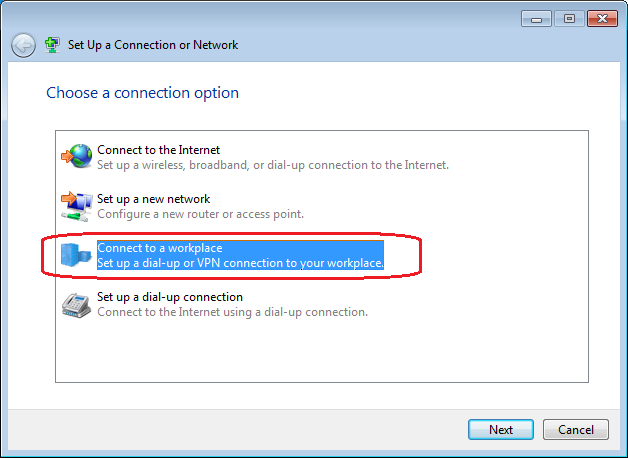Connecting to the Botany VPN on Windows 7
Initial Configuration
You can use the built-in Windows 7 VPN client to connect to the Department of Botany VPN. The setup is somewhat involved, but easy enough to do if you follow the instructions below. You should only have to follow these instructions once to setup the VPN adapter on your system. If you already have followed them once, skip ahead to the Connecting to the VPN Server section below.
To start, select the Start menu, then choose Control Panel on the right side of the Start Menu.

Once the control panel has opened, look for the Network and Internet option. Click on View network status and tasks.
You should now be looking at the Network and Sharing Center. Click on Set up a new connection or network.
In the new window ("Set Up a Connection or Network"), choose the Connect to a workplace option.
Click on Use my Internet connection (VPN).
Fill in the next screen with the following information:
- Internet Address: winvpn.botany.wisc.edu
- Destination Name: Arbitrary, but I suggest something like UW-Madison Botany VPN
Fill out the next screen using your username and password. If you don't have a username and password, please contact Botany IT. You can check the Remember this password box unless you want to type the password in every time you connect. Make sure to leave the "Domain" box empty.
Click on the Create button. This will tell you that the connection is now ready for use. Click on the Close button. That should bring you back to the Network and Sharing Center.
In the upper left-hand corner of the window, click on Change adapter settings.
You should now see a window with icons for all your VPN connections and physical network adapters (Ethernet, wi-fi, etc.).
Right-click on the VPN adapter that you created above (probably named UW-Madison Botany VPN) and choose Properties.
You should now be looking at a window with tabs across the top. Click on the Options tab.
In the "Dialing options"portion of the window, uncheck Prompt for name and password, certificate, etc. if you chose to have Windows remember your password when setting up the VPN adapter.
Also, uncheck Include Windows logon domain.
Now click on the Security tab.
Under "Type of VPN" choose Layer 2 Tunneling Protocol with IPsec (L2TP/IPSec).
Uncheck Challenge Handshake Authentication Protocol (CHAP). Ensure that "Microsoft CHAP Version 2 (MS-CHAP-V2)" remains checked, however.
Then, click on the Advanced Settings button.
Click on the Use preshared key for authentication button. Enter the preshared key you received from Botany IT. Click OK.
Now click on the Networking tab. Uncheck Internet Protocol Version 6 (TCP/IPv6).
Click on Internet Protocol Version 4 (TCP/IPv4) and then click the Properties button.
On the next screen, click on the Advanced button. In the "Advanced TCP/IP Settings" window, uncheck Use default gateway on remote network and click OK.
Click the OK button twice more to exit the configuration window.
Congratulations! Your VPN adapter is now ready for use.
Connecting to the VPN Server
If you have successfully completed the steps above, your VPN adapter is ready for use.
There are several methods available to initiate the VPN connection. Shown below is just one of them.
In the lower right-hand corner of the screen you should see a network icon in the taskbar.

Click on that icon to bring up a screen that displays the active and potential network connections on your system. You should see the Botany VPN adapter that you created above.

Click once on that adapter and you get a connect button. Click once on the Connect button to initiate a connection to the VPN server.

A dialog box will appear in the middle of the screen giving you some information about the connection process. If all goes according to plan, the dialog box will go away and when you check on the status of your network connections again you'll see that you're connected to the Botany VPN.

You can now start using resources on the Botany network.
If the connection does not succeed, Windows 7 will pop-up a dialog box in the middle of the screen with some extremely basic diagnostic information. Please take note of the current date and time, and the contents of the dialog box and contact Botany IT with that information.
Disconnecting from the VPN
The process of disconnecting from the VPN is fairly easy. Again, there are several ways to go about this process but I'll cover just one.
In the lower right-hand corner of the screen you should see a network icon in the taskbar.

Click on that icon to bring up a screen that displays the active and potential network connections on your system. You should see an indication that you're connected to the Botany VPN.

Click on the VPN. Cick on the Disconnect button.

That's it. You're disconnected from the VPN.
↑ Up: Department of Botany VPN













